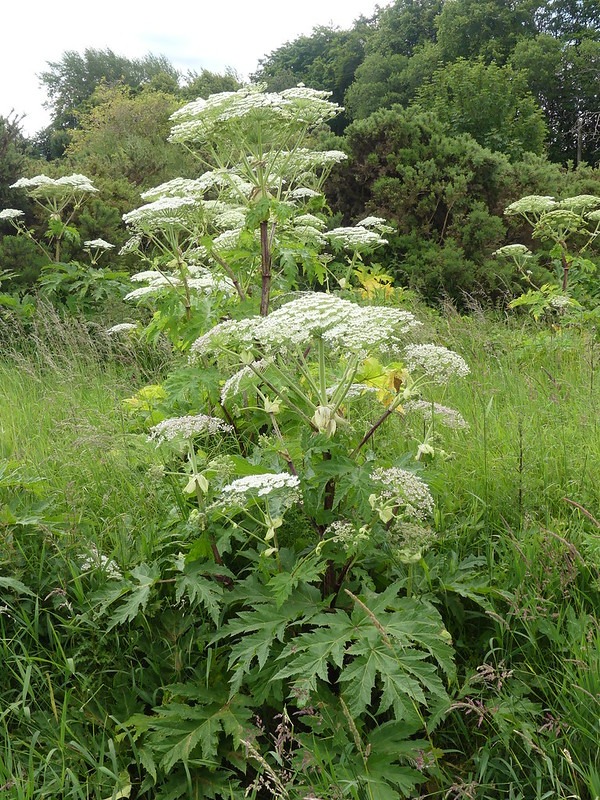Contents
- Introduction
- The Spread of Giant Hogweed
- Health Hazards
- Legal Responsibilities
- Environmental Impact
- Control and Management
- Conclusion
- Resources
Introduction
Have you ever walked through your garden and stumbled upon a towering, umbrella-like plant that looks somewhat out of place? If you’re a landowner in the UK, there’s a good chance you might have encountered giant hogweed. But what is it, and why is it causing such a stir? Let’s dive in and see what kind of trouble giant hogweed can bring to your doorstep.
The Spread of Giant Hogweed
Giant hogweed, or Heracleum mantegazzianum, isn’t just another oversized plant. This invasive species originally hails from the Caucasus region but has found its way into the UK, spreading like wildfire. It thrives in a variety of environments, especially along riverbanks, roadsides, and wastelands. Once established, it’s notoriously difficult to eradicate.

Health Hazards
One of the most alarming issues with giant hogweed is its serious health risks. The plant’s sap contains furanocoumarins, which react with sunlight to cause severe skin burns and blisters. Even brushing against it can lead to painful, long-lasting scars. It’s particularly dangerous for children and pets who might unknowingly come into contact with it.
Legal Responsibilities
Did you know that as a landowner, you’re legally obliged to control giant hogweed on your property? Under the Wildlife and Countryside Act 1981, it’s an offence to plant or cause giant hogweed to grow in the wild. Failure to manage it properly could lead to hefty fines or even legal action from neighbours affected by its spread.
Environmental Impact
Giant hogweed doesn’t just pose risks to humans; it can wreak havoc on local ecosystems too. It outcompetes native plants for resources, leading to reduced biodiversity. Its dense canopy can overshadow other plants, preventing them from getting the sunlight they need to thrive. This can result in soil erosion, especially along riverbanks, affecting water quality and local wildlife.
Control and Management
So, how do you tackle this green menace? Controlling giant hogweed requires a multi-faceted approach. Here are some tips:
Identify the Problem
Giant Hogweed is not just an invasive plant; it’s also a serious health hazard. Its sap can cause severe skin irritation, blistering, and even long-term scarring when exposed to sunlight. Correctly identifying this plant is crucial for your safety and the well-being of your property. If you’re unsure whether the plant on your land is Giant Hogweed, consult a trained professional. Misidentifying it could lead to ineffective treatment and unnecessary risk, so getting it right from the start will save time and prevent potential harm.
Assess the Situation
Once you’ve confirmed the presence of Giant Hogweed, it’s important to assess the scope of the problem. Is the infestation limited to a small patch, or has it spread across your property? Small infestations can sometimes be managed with diligent effort, but larger areas require a strategic approach. Remember, Giant Hogweed can spread quickly and aggressively if not addressed early. For widespread growth, professional intervention is highly recommended. Experts can provide a thorough assessment and devise a customised treatment plan to prevent the plant from overtaking your landscape.
Hire a Professional
Removing Giant Hogweed is not a DIY project—it’s a complex and potentially hazardous task. Hire a licensed, insured contractor who specialises in controlling invasive species. These professionals not only have the expertise to identify and manage Giant Hogweed, but they also come equipped with advanced tools and protective gear to handle the job safely. The right contractor will follow local regulations, ensuring the plant is removed in a way that prevents future outbreaks. Working with experts minimises your risk of exposure to harmful sap and guarantees compliance with environmental protection standards.
Chemical Control Methods
While herbicides can be an effective tool for controlling Giant Hogweed, they come with risks that should not be taken lightly. Incorrect application of chemicals can damage surrounding vegetation, harm wildlife, and contaminate nearby water sources, leading to long-term ecological damage. That’s why it’s essential to leave herbicide application to professionals. They will choose the right product and method based on the specific conditions of your property. Licensed experts know how to minimise collateral damage, use chemicals responsibly, and adhere to safety protocols, ensuring both effective treatment and environmental protection.
Non-Chemical Control Methods
If you prefer a more environmentally friendly approach, non-chemical methods like cutting, mowing, or digging up Giant Hogweed can be used—but they’re not for the faint of heart. These manual removal strategies require a lot of physical labour and must be performed with extreme care. Cutting too high or leaving fragments of the plant behind can result in rapid regrowth. Proper disposal of plant material is critical to prevent further spread. Always bag and seal the plant parts before disposal, and never compost them. For those who prefer to avoid chemicals but are concerned about regrowth, pairing non-chemical methods with professional monitoring offers a balanced solution.
Monitor and Follow-up
Treating Giant Hogweed is not a one-time job—it requires continuous monitoring. After the initial removal, stay vigilant for any signs of regrowth, especially during peak growing seasons. This resilient plant can regenerate from even the smallest root fragments. Regular inspections of the treated areas will help ensure that any resurgence is caught early before it spreads again. If you notice any new growth, contact your professional service immediately. They can provide follow-up treatments and adjust your management plan as needed. Consistent monitoring is key to long-term control and protecting your landscape from future infestations.
Conclusion
Giant hogweed is more than just a nuisance; it’s a serious threat to health, the environment, and your legal standing as a landowner. By understanding the problems it causes and taking proactive steps to manage it, you can protect yourself, your property, and your community. Got any stories or tips about dealing with giant hogweed? We’d love to hear from you!
Resources:
The Postcode Areas We Serve
Gloucester and Swindon
Birmingham and the Midlands
Bristol and the South West
Cardiff and South Wales










